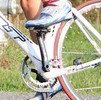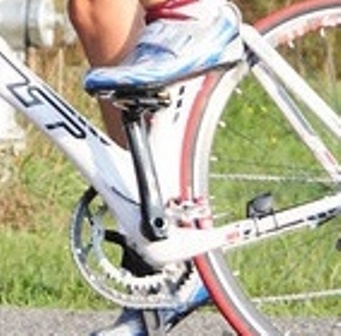Bicycle Cleat Float, Knee Pain, and You; installing cleats
Posted by Matt Russ on 31st Aug 2018
The most common malady I encounter in bike fitting is knee pain, and the first place I address this is at the foot/pedal interface. There are five components to adjustment at the foot/pedal interface but I would like to discuss the one that is most commonly off- rotational adjustment. If you had your bike shop install a new seat of cleats while you wait they, probably said they will set them to "neutral" which means I am going to put them somewhere in the middle with no regard to your biomechanics. Perhaps you have been riding them this way for some time; after all "neutral" sounds good enough. But in fact there is a huge spectrum of biomechanics that should be addressed here, and until somewhat recently pedal design failed miserably in range of adjustment.
Consider two cyclists; one is a 240 pound line backer, the other a 90 pound ballerina. Standing next to each other they may hardly look to be the same species, yet the stance width adjustment at their cleats (or Q factor) is only a few millimeters. They both have to ride the same pedal and pedal spindle length with a range of adjustment that cannot possibly match their bodies. Speedplay was the first to address this to a high degree with 5 different pedal spindle lengths and more stance width adjustment at the cleat. This allowed the selection of pedal spindle length that could actually and properly line up the foot and knee under the hip; a night and day improvement for a lot of riders. Several brands now offer 2 or more pedal spindle lengths. From a fitter perspective the more range and type of adjustment we have, the more we can address riders that are outside that narrow band of "normal" riders. Just like bicycle frames the more sizes you produce the more expensive a model becomes. It is more cost effective to produce just a few sizes, or in the case of pedals just one. Bear that in mind when you make your pedal purchase; especially if you ride a very large or very small bicycle frame size.
I like to begin a fitting by watching a client walk away and towards me. So much can be gained from this simple observation: is the client pigeon toe'd or duck footed, is one hip higher than the other, does one foot rotate outwards more than the other, are they flat footed or high arched, do they have wide or narrow hips, etc., etc.. When it comes to the rotational adjustment of the cleat I am looking to match their natural biomechanics. Most riders feet externally rotate outwards, sometimes with one foot out more than the other. What is bicycle cleat float? It is the number of degrees the foot can move while engaged to the pedal. The goal is to put the foot in it's natural position in the center of the cleat float. In other words, assuming they have 6 degrees of float, the foot should naturally reside with about 3 degrees of play medial and laterally. This can be a hard target to hit but if I stop the clients foot randomly within the pedal stroke I can move the heal several degrees in either direction without hitting the fixed points in their float. I also query the rider whether they feel their foot is being forced or held into a pedal position. It should feel natural.
Most cleats come in 2-3 ranges of float starting with zero or a "fixed" position. This is the hardest to adjust as it needs to match the clients biomechanics almost perfectly. It also does not leave any room for "slop" or movement in the pedal stroke. You not only have to adjust the rotation perfectly, you should have a very clean pedal stroke. For these reasons alone a zero float cleat is usually not a good choice for most riders. There is a lot going on biomechanically within the pedal stroke, for instance the tibia internally rotates slightly with each pedal stroke. By inhibiting this movement the stress is transferred to the body, specifically the knee. If you have very diverse biomechanics or a sloppy pedal stroke more float is usually warranted. Speedplay takes a different approach with their X series pedal allowing unlimited float or Zero series adjustment from 15 degrees to zero. There is evidence that a zero float system allows more power transfer, but there is also greater risk of an "itis" overuse injury.
I find that the client's foot is going to naturally go where it wants to. I never attempt to put the foot in a place it does not want to go. Properly addressing varus/valgus, leg length discrepancies, stance width, and fore/aft adjustment often removes a lot of pedal slop. Adjusting the bike, specifically seat height and fore/aft removes a lot of pedal slop. Once we have all these things lined up, and rotational adjustment matching their biomechanics, the next stop is form. The body has to take up the slack for an improperly fitted bike or foot/pedal interface. For instance the knees will naturally flare out in the case of a seat being too low. The client develops a "knees out" pedal stroke as a result, and this habit is not completely removed with a fitting. Usually the first thing I attempt to change is getting their knees in proper alignment medially, or eliminating "knees out" lateral movement. "Ankling" or excessive extension/flexion from the ankle is another common form issue which again could have been trained by a seat that is too high. A bike fitting is the true "neutral" point and often cleans up the pedal stroke. Leverage is gained to produce more power, and power that was misdirected from the pedal spindle is removed. It is also a starting point, not an end point, and more fine tuning may be warranted as the rider gets some miles on a fit.



